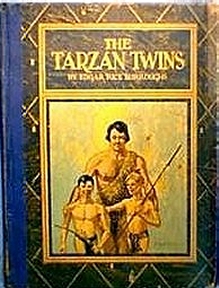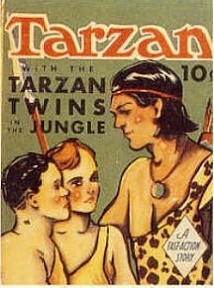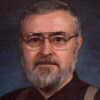
Official Edgar Rice Burroughs Tribute and Weekly Webzine Site Since 1996 ~ Over 15,000 Webzines in Archive |

Official Edgar Rice Burroughs Tribute and Weekly Webzine Site Since 1996 ~ Over 15,000 Webzines in Archive |
 |
The Morphology of a Folktale by Edgar Rice Burroughs by David Arthur Adams (First published by ERB Collector, Issue #40 November 1999) |
ForewordThe Tarzan Twins is the first of two fairy tales written about Dick and Doc, the “Tarzan Twins.” This story along with Tarzan and The Tarzan Twins with Jad-bal-Ja the Golden Lion were written specifically for an audience of children rather than for adults, as were the other 24 Tarzan novels.
Edgar Rice Burroughs is recognized as being a great story teller, in fact, this is nearly the only critical point about his writing that is agreed upon without question. Since ERB wrote at least these two stories specifically for children, I thought it be interesting to see if these tales fall within the typical structures of the folktale or fairy tale as outlined by academic folklorists.
A great deal has been written about the folktale in general, especially about a popular branch of this genre -- the fairy tale. The study of this type of literature is an important academic area that falls under the headings of anthropology, folklore, and linguistics. In fact, so many studies have been written about folklore alone that to fully understand it all would take a lifetime of specialized concentration.
Scholars who collect the thousands of folktales throughout the world have developed many systems of classifications for these stores. Antti Aarne, the great Finnish folklorist, even constructed an index for the classification of folktales that attempts a scientific method akin to ones used by biologists in labeling flora and fauna.
This article concerns itself with but one of these many works called the Morphology of the Folktale by the great, Russian folklorist, Vladimir Propp (1895-1970). It is not my purpose to argue the validity of Propp’s theories since this article is written for a popular audience that is more interested in the works of Edgar Rice Burroughs rather than arcane studies on the folktale. The interesting thing about Propp’s work is the fact that he developed a method to study the tale according to the functions of its dramatis personae. He claims that these “functions” or acts of a character are limited in number and follow a more or less identical sequence. This outline can easily be applied to the Tarzan Twins stories of Edgar Rice Burroughs.
The word “morphology” simply means the study of forms -- the study of component parts in their relationships to each other and to the whole -- in other words, the study of the story’s structure. An application of Propp’s list of “functions” to The Tarzan Twins reveals that this story does indeed follow the system to a remarkable degree, as you will see in the following analysis. Perhaps this formal study may reveal some of the reasons why Burroughs, was such a great natural storyteller.
I have used Propp’s outline for a study of the second of ERB’s “children’s stories,” Tarzan and The Tarzan Twins with Jad-bal-ja the Golden Lion , and it works remarkable well in that case as well. However, the interesting things about The Tarzan Twins is the fact that not a single substitution of functions is necessary. Even though Propp does allow functions from the middle of the tale to occur earlier, such a break in the “pure” form does not happen in this Burroughs story.
A Morphological Study of Dick and Doc are not really twins, but cousins born to twin sisters. The sisters were American girls, but Dick’s mother married an Englishman, a distant relative to Lord Greystoke. Dick and Doc looked alike but for their hair - - Dick had “a shock of the blackest sort of hair, while Doc’s “was the sunny hue of molasses candy.” They both had blue eyes.
Tarzan and the Tarzan Twins and the Golden Lion
According to Propps’ “Functions of Dramatis Personae”[The numbered items are Propp’s “functions”. The small case explanations which sometimes immediately follow the functions are also Propp’s own words.]
Introducing the Tarzan TwinsAt the age of 14, the boys attended school in England together where they picked up the title of “The Tarzan Twins” due to Dick’s heritage.
I. One of the members of a family absents himself from home.
Sometimes members of the younger generation absent themselves -- they go visiting.The boys are invited to spend two months on Tarzan’s African estate. They are allowed to go by
themselves when their parents are unable to accompany them. Tarzan is to meet them at the end of the railway with 50 Waziri warriors.
II. An interdiction is addressed to the hero.
On the train, Doc passes the time by doing magic tricks, slight of hand coin maneuvers. Their railway carriage is derailed, and the boys are warned not to go into the jungle by a train guard, but they do so anyway.
III. The interdiction is violated, and a villain enters the tale
They wander some distance, then hearing a terrific roar, run back along the wrong trail. Retracing their steps, the boys meet a Numa, a great black-maned lion. .
IV. The villain makes an attempt at reconnaissance.
The lion attacks them, and the boys run for the trees
V. The villain receives information about his victim. (Definition: delivery)
Dick saves Doc by turning back to help him when he is tripped by a root. The boys start off through the trees, hoping to reach the train. but night falls.
VI. The villain attempts to deceive his victim in order to take possession of him or of his belongings.
They find a game trail which leads to a cannibal village. They are followed by Zopinga, a Mugalla of the Bagalla tribe, the all-powerful ones in Ugalla.
VII. The victim submits to deception and thereby unwittingly helps his enemy.
Seeing the village, the boys turn back .. .
VIII. The villain causes harm or injury to a member of a family.
This may be an abduction.This function is exceptionally important, since by means of it the actual movement of the tale is created. The first seven functions may be regarded as the preparatory part of the tale, whereas the complication is begun by an act of villainy. The forms of villainy are exceedingly varied.
. . .but they are herded at spear-point into the enclosure by Zopinga.
IX. Misfortune or lack is made known; the hero is approached with a request or command; he is allowed to go or he is dispatched.
This function brings the hero into the tale.Dick saves Doc from a blow from a heavy stick by punching a native boy in the face. Dick is the hero of this tale, whereas Doc becomes the hero in the second story, TTTJGL.
X. The seeker agrees to or decides upon counteraction.
A volitional decision, of course, precedes the search.They try to communicate with the chief without success.
XI. The hero leaves home.
The departure is intensified.The boys are kicked into a stinking bee-hive shaped hut.
XII. The hero is tested, interrogated, attacked, etc., which prepares the way for his receiving either a magical agent or helper
In the hut the boys meet two other captives. One is Bulala, “a densely ignorant, but happy-natured West Coast black” who was captured while running away from a safari where he had been a cook. The other is Ukundo, a clever pygmy.
XIII. The hero reacts to the actions of the future donor.
He performs a service of some kind, such as showing mercy.The boys quickly make friends with the captives.
XIV. The hero acquires the use of a magical agent.
This may be a capacity.They learn a West Coast native language with a pygmy dialect, which proves to be useful.
XV. The hero is transferred, delivered, or led to the whereabouts of an object of search.
Generally the object of search is located in “another” or “different” kingdom. This kingdom may lie far away horizontally, or else very high up or deep down vertically. He may fly through the air or find a stairway or underground passageway.They fall asleep that night knowing they are in the midst of cannibals.
XVI. The hero and the villain join in direct combat.
In humorous tales the fight itself sometimes does not occur. The hero and the villain may engage in a competition . The hero wins with the help of cleverness.In the morning the boys are taken before Chief Galla Galla. He promises to release them in a few days if they will give him their clothes. (Bulala is the translator in this exchange.) While changing into filthy calico rags, the chief demands Doc’s fountain pen. Doc tells him it is something to drink, and the chief spits blue. They try to hide their knives, but the chief demands them also. Doc does his disappearing trick, pulling the knife out of Galla Galla’s left ear, and this surprises him so much that he falls off his stool. When he still demands the knives, Doc tells him they are hidden in the head of the boy whom Dick had struck the day before.
XVII. The hero is branded.
The sign that the boys have changed their status is of course the filthy calico rags they are forced to wear instead of their “civilized” clothes. The Chief is literally “branded” in a comic reversal by the ink from Doc’s fountain pen.
XVIII. The villain is defeated.
The Chief is defeated in his effort to have the boy’s knives.They are kept prisoner for many hot days and cold nights. The boys are allowed the freedom of the village compound during the day due to the threats of the white boy witch-doctor -- Doc.
In chapter seven “The Knives Reappear” the combat scene with the Chief is given another twist, and the clever Doc again plays a reversal to defeat his enemy.
Paabu, the boy whose head holds Doc’s magic, fears that Galla Galla will harm him to find the secret. Intamo, the ugly, evil witch-doctor of the Bagalla, has persuaded Galla Galla to crack open Paabu’s head like a nut. However, Doc pulls the knives out of Paabu’s ear before Intamo can strike him with his knobkerrie.
XIX. The initial misfortune or lack is liquidated.
He then places the knives in the witch-doctor’s head, suggesting that the war club could be used on him as well. The boys have a dangerous enemy.
XX. The hero returns.
A return takes place immediately and, for the most part, in the same forms as an arrival. Sometimes return has the nature of fleeing.That same afternoon guests arrive for the cannibal feast. Bulala is taken away to another hut, and the boys ask Ukundo to help them escape. Doc promises to prevent the night demons from harming them.
XXI. The hero is pursued.
An attempt may be made to kill the hero.That evening, as the cannibals are getting the cooking pots ready, Paabu warns them that Intamo, the evil witch-doctor, intends to poison them.
Chapter Eight - Plotting An Escape
Paabu promises to bring them four knives, four spears, and four bows and some arrows in exchange for one of Doc’s magic knives. They bury the poison food and wait for Paabu to return.
XXII. Rescue of the hero from pursuit.
From this point onward, the development of the narrative proceeds differently, and the tale gives new functions.Paabu returns with the weapons. The cannibals are preparing for the feast, which will happen the
following evening. As soon as the natives retire for the night, Intamo comes to their hut and tries to kill Doc with his knobkerrie. Dick intervenes with a spear, but it is Ukundo who kills the evil one with his knife.They go to the hut that holds Bulala, and Ukundo enters the gloom and brings him out. They remove the chain from the village gates, but the noise awakens the village dogs. The cannibals come with their spears but are afraid to go into the jungle at night as the four prisoners run away amidst the demons of the darkness.
XXIII. The hero, unrecognized, arrives home or in another country.
Sometimes the initial villainy is repeated, sometimes in the same forms as in the beginning.Ukundo, master of jungle craft, leads them through the mass of tangled vegetation. Ukundo tells them a lion is coming, and they run through the absolute darkness. The boys find a tree but no branches to climb. Dick jabs his spear into the darkness and feels a heavy body strike, throwing him to the ground. Doc finds a tree they can climb, and they listen to the angry lion thrashing about in the underbrush. Ukundo and Bulala have also found trees to climb, so they decide to stay there until morning.
The interesting twist of the lion reappearing in this story fits Propp’s thesis of an initial villainy being repeated, as the boys were chased by a lion in Function IV above.
XXIV. A false hero presents unfounded claims.
At first light, they find a dead lion impaled by Dick’s spear. Dick wants at least the head, but he
settles for taking the lion’s tail.Since this is a comic tale, or at least a tale with comic elements, Dick is put in the position of a comic hero rather than introducing a new, false one. He only gets the tail of the lion, and as Doc wryly notes, “it’s about all of it you’ll feel like carrying after an hour or so.”
XXV. A difficult task is proposed to the hero.
The boys proceed with bleeding feet and bodies torn and scratched by thorns. When they reach a clearing, they are attacked by three-score Bagalla warriors. They all decide to stand and fight. The boys can’t shoot the native bows well enough to do any harm, but Ukundo kills one of the cannibals.
XXVI. The task is resolved.
Just as they are about to be captured again, Tarzan and his Waziri arrive. The cannibals run away like frightened rabbits.
XXVII. The hero is recognized.
This may be a special mark or a simple recognition of accomplishments.Tarzan calls them “brave lads.” And continues, “In the jungle only the brave may live. I am very proud of you.”
XXVIII. The false hero or villain is exposed.
Since there is no real false hero in this tale, the exposure is revealed in the simple fact that the boys could not really shoot the bows; they could not really save themselves.
XXIX. The hero is given a new appearance.
Transfiguration. Sometimes a change of dress.The real heroes arrive on the scene, Tarzan with his Waziri warriors. There is a transformation of sorts in that the boys think more of the enemy is arriving. “And sure enough, with waving plumes there came what seemed a veritable horde of mighty warriors, grim and savage . . .”
XXX. The villain is punished.
The cannibals are pursued by the Waziri warriors, “who showered arrows and spears among them.” We may assume they were sufficiently punished.
XXXI. The hero is married and ascends the throne.
The boys introduce Ukundo and Bulala to Tarzan, who promises them a reward. Doc asks for a whole apple pie.The ending is an example of ERB’s tongue-in-cheek humor. Instead of marrying the princess or gaining a kingdom, the boys ultimate reward is an apple pie.
The application of Propp’s functions to the short stories in the Jungle Tales of Tarzan reveals that not only do they fit these tales, but they also uncover some interesting new aspects in their fundamental structures. I have found Propp’s functions to be an enlightening method of structural analysis and a particularly fruitful one for dealing with the typical folktale structures in the “Tarzan Twins” tales. Burroughs was able to create perfect fairy tales with apparent ease, which may explain at least in part his fame as a “natural storyteller.”
AfterwordBurroughs, Edgar Rice. Tarzan and the Tarzan Twins, Canaveral Press, 1963.
Bibliography
Propp, V., Morphology of the Folktale, University of Texas Press, 1990.
July 10, 1999
around 2700 words
For more Tarzan Twins art see ERB C.H.A.S.E.R. at:
www.erbzine.com/mag4/0498.html

The
Navigation Chart for the
David
Adams
Features
in ERBzine
![]()
![]()
![]()
![]()

![]()
BILL
HILLMAN
Visit
our thousands of other sites at:
BILL
and SUE-ON HILLMAN ECLECTIC STUDIO
ERB
Text, ERB Images and Tarzan® are ©Edgar Rice Burroughs, Inc.-
All Rights Reserved.
All
Original Work ©1996-2005/2016 by Bill Hillman and/or Contributing
Authors/Owners